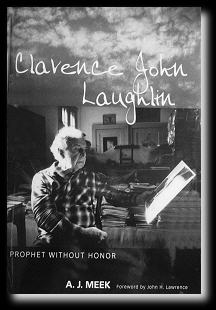|
A biography of a New Orleans photographer of worldwide acclaim Clarence John Laughlin (1905-1985) of New Orleans is arguably the father of photographic surrealism in America. He was best known for his photographs of old plantation homes and his book, Ghosts Along the Mississippi, but his lifeís work was varied and broad. Laughlin was a mainstream photographer who was published in many national magazines. His contemporaries and associates included photographers Minor White, Wynn Bullock, and Edward Weston, as well as legendary editor Maxwell Perkins. Laughlin was, however, often marginalized and ignored due to misunderstandings of his work and his often volatile personality. Equally annoying to many was his devotion to capturing images that depicted, with an evangelical zeal and sometimes disturbing sense of self-righteousness, the evil and poverty that he saw in the world. A. J.
Meek looks into the controversial life of one of the greatest
photographers in American history. Through interviews with
Laughlinís colleagues, friends, and family, the author details the
tumultuous connection between the struggles of the artistís life,
including strained working relationships and failed marriages, and
the work that brought him professional fame. "Meek paints a fascinating
portrait of the Lake Charles native, who was a boy of 14 when his
father died in the great flu epidemic of 1918. With a grieving
mother and a crippled sister to support and care for, Laughlin's
family life was demanding to say the least; his life would follow a
pattern of responsibility and flight. He would marry five times --
twice to the same woman, Elizabeth Heintzen -- and he would not know
his three children well during his lifetime. ... Meek, in this
admiring yet clear-eyed biography, makes us see the man behind those
melted dreams, appreciate his achievements as well as his
shortcomings, in a welcome look at a true New Orleans original." "The book is by A.J. Meek,
professor emeritus of art at LSU. Meek combines biography and
criticism with reproductions of some of Laughlinís black and white
photographs to explain the artistís complex creations. Early on,
Meek says, Laughlin showed his maverick streak. Related: Fortuneís Favorite Child Ida Kohlmeyer: Recent Works |
